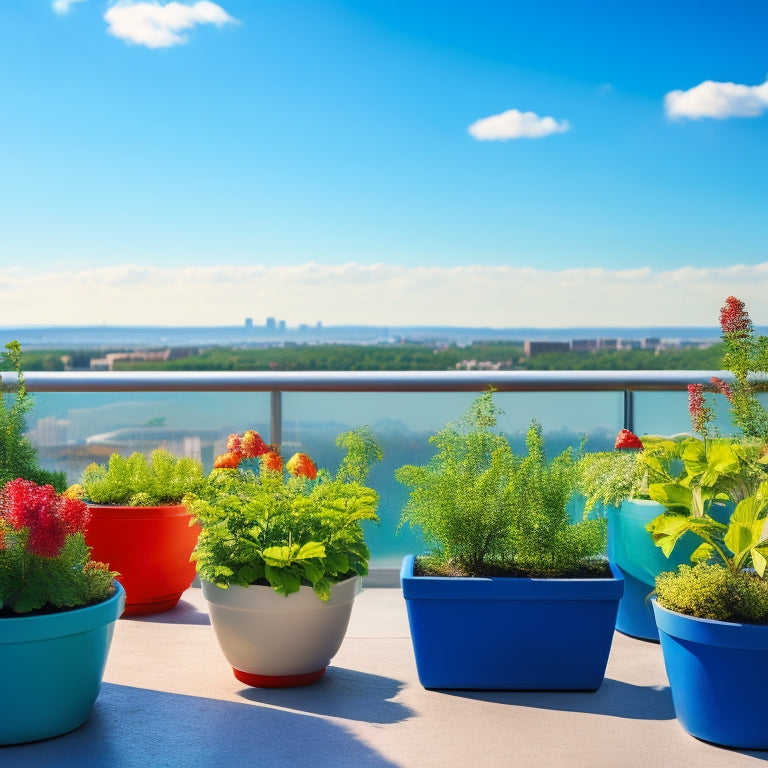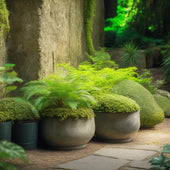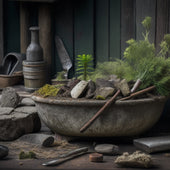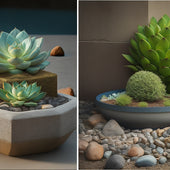
Strawberry Rooftop Delights: Best Planters for Small Spaces
Share
You can turn your small rooftop space into a thriving strawberry garden by choosing the right planter. Select a planter that's at least 6-8 inches deep and 12-18 inches wide to accommodate 2-3 plants, leaving 1-2 inches between them for air circulation. Durable materials like fiberglass or ceramic are ideal, and consider hanging planters for improved air circulation and reduced disease risk. For best watering, opt for self-watering planters with a minimum 1-2 liter water storage capacity. By selecting the right planter, you'll be well on your way to a bountiful strawberry harvest - and with a few more expert tips, you can access your rooftop's full potential.
Key Takeaways
• Choose strawberry varieties like 'Albion' and 'Camarosa' that resist powdery mildew and botrytis, and suit your taste preferences.
• Select planters that are at least 6-8 inches deep to support healthy root growth and retain moisture.
• Durable materials like fiberglass or ceramic planters are ideal for withstanding elements and supporting plant weight.
• Hanging strawberry planters offer a space-saving solution, improve air circulation, and reduce fungal disease risks.
• Consider self-watering planters with a minimum water storage of 1-2 liters to ensure optimal watering and reduce maintenance.
Choosing the Right Strawberry Variety
When selecting a strawberry variety for your small space planter, consider factors like fruit size, yield, and disease resistance to confirm you're getting the most out of your compact garden. You want a variety that will thrive in limited space and provide a bountiful harvest.
Look for varieties with built-in disease resistance, such as 'Albion' or 'Camarosa', which are resistant to powdery mildew and botrytis. These varieties will reduce the risk of disease and confirm a healthy crop.
Flavor profiles are also an important consideration. Do you prefer sweet and juicy strawberries or tart and tangy ones? 'Everbearing' and 'day-neutral' varieties, like 'Fern' and 'Florence', offer a sweet flavor profile and produce multiple harvests throughout the growing season.
If you prefer a tangier flavor, 'June-bearing' varieties like 'Earliglow' and 'Sparkle' are a great choice. By choosing a variety that suits your taste preferences and growing conditions, you'll be enjoying fresh, delicious strawberries from your small space planter in no time.
Rooftop Planter Size and Depth
Select a rooftop planter that's at least 6-8 inches deep to provide ample room for your strawberry plants' roots to grow, guaranteeing a healthy and thriving harvest. This depth allows the roots to spread out and absorb essential nutrients and water. When choosing a planter, consider the planter dimensions and root depth to guarantee your strawberries have enough space to flourish.
A deeper planter also means you'll need to water less frequently, as the soil will retain moisture better. Additionally, a deeper planter reduces the risk of waterlogged soil, which can be detrimental to your plants.
Aim for a planter that's around 12-18 inches wide and 6-8 inches deep. This size will provide enough room for 2-3 strawberry plants, depending on the variety. Remember to leave about 1-2 inches of space between each plant for proper air circulation and sunlight penetration.
Material Matters for Durability
You'll want to contemplate planters made from durable materials that can withstand the elements and support the weight of your strawberry plants, as well as the soil and water they'll require.
When it comes to planter materials, you have several options to choose from, each with its own strengths and weaknesses.
For instance, ceramic planters are known for their weather resistance and can add a touch of elegance to your rooftop garden. However, they can be heavy and prone to cracking.
Plastic planters, on the other hand, are lightweight and affordable, but may not be as durable as other options.
Wooden planters offer a natural look and can be made from sustainable materials, but they require regular maintenance to prevent rot and decay.
Fiberglass planters provide a durable and low-maintenance option, but may not be as aesthetically pleasing as other materials.
Ultimately, the right planter material for you will depend on your specific needs and preferences. Be sure to choose a material that can withstand the elements and support the weight of your strawberry plants.
Hanging Strawberry Planters Benefits
Hanging strawberry planters offer a space-saving solution, allowing you to make the most of your small space while still enjoying a bountiful harvest. By elevating your strawberries, you'll improve air circulation, reducing the risk of fungal diseases that thrive in humid environments. This also makes it easier to monitor your plants for signs of pests, enabling you to take prompt action for effective pest management.
Another advantage of hanging planters is the opportunity for companion planting. You can pair your strawberries with herbs like basil or mint, which repel pests that target strawberries. This symbiotic relationship not only enhances the flavor of your strawberries but also promotes a healthier growing environment.
Additionally, hanging planters keep your strawberries away from marauding animals and curious children, ensuring your harvest remains intact. With hanging planters, you can create a thriving strawberry garden even in the smallest of spaces, enjoying the sweet taste of success without sacrificing precious square footage.
Self-Watering Planters for Strawberries
When choosing a self-watering planter for your strawberries, you'll want to take into account two key features: water storage capacity and automatic irrigation systems.
You'll need to reflect on how much water your strawberries will need and how often the planter will refill.
Water Storage Capacity
With self-watering planters, strawberries can thrive in small spaces, and a minimum water storage capacity of about 1-2 liters is recommended to confirm the plants receive a steady supply of moisture. This capacity guarantees that your strawberries get the right amount of water, even when you're not around to water them manually.
When choosing a self-watering planter, look for one with a built-in water reservoir that allows for efficient moisture retention. This feature prevents waterlogged soil and reduces the risk of root rot.
Additionally, consider planters with advanced drainage solutions, such as built-in mesh or holes, to prevent water from accumulating in the soil. This way, you can enjoy a bountiful strawberry harvest without worrying about your plants drying out or drowning.
Automatic Irrigation Systems
You can take your strawberry growing to the next level by incorporating automatic irrigation systems into your small-space gardening setup, guaranteeing your plants receive exactly the right amount of water at the right time. This is especially vital in small spaces where waterlogged soil can be detrimental to plant health.
Self-watering planters with built-in drip irrigation systems are an excellent option. These systems deliver water directly to the roots, reducing evaporation and runoff. You can also pair them with timer systems to customize watering schedules according to your strawberries' needs. For example, you can set the timer to water your plants every 2-3 days during hot summer months.
This not only saves you time but also guarantees your strawberries receive consistent moisture levels. By automating irrigation, you'll reduce the risk of overwatering and underwatering, creating a safe and healthy environment for your strawberry plants to thrive.
Space-Saving Vertical Gardening
Your small balcony or patio can become a lush oasis by utilizing space-saving vertical gardening, which maximizes every inch of available space. As an urban gardener, you can create a thriving container garden even in the smallest of spaces. Vertical gardening is perfect for small balconies, patios, or rooftops, allowing you to grow more plants in a limited area.
Here are some benefits of vertical gardening:
| Benefits | Description |
|---|---|
| Increased Yield | Grow more plants in a smaller space |
| Space Efficiency | Maximize every inch of available space |
| Improved Air Circulation | Better air circulation reduces disease risk |
| Visual Appeal | Add a decorative element to your outdoor space |
Frequently Asked Questions
Can I Grow Strawberries in Partial Shade on My Rooftop?
'When life gives you shade, make shade-tolerant strawberries! You can grow them on your rooftop, but choose varieties like 'Albion' or 'Camarosa' and select containers with good drainage to guarantee a bountiful harvest.'
How Often Should I Fertilize My Rooftop Strawberry Plants?
You'll want to fertilize your rooftop strawberry plants every 10-14 days during the growing season, using a balanced, water-soluble fertilizer; consider a fertilizer with micronutrients for peak growth, and follow the product's feeding schedule.
Will Strawberries Attract Bees and Other Pollinators to My Rooftop?
You'll be thrilled to know that one-third of the food we eat is thanks to pollinators! Yes, strawberries will attract bees and other pollinators to your rooftop, bringing pollinator benefits and even attracting butterflies, ensuring a sweet harvest while maintaining a safe environment.
Can I Use Regular Potting Soil for My Rooftop Strawberry Planters?
You shouldn't use regular potting soil for rooftop strawberry planters, as it can retain too much water, causing root rot. Instead, opt for well-draining potting soil types and consider adding drainage solutions like perlite or vermiculite to guarantee healthy growth.
How Do I Protect My Rooftop Strawberries From Strong Winds?
'Did you know 60% of rooftop gardens fail due to wind damage? To protect your strawberries, you'll need wind barriers, like trellises or screens, to deflect strong gusts and guarantee container stability, securing your planters firmly to the rooftop.'
Related Posts
-

10 Best Shade Garden Planters Using Concrete Blocks
You're about to discover the perfect way to add industrial chic to your shade garden while ensuring healthy plant gro...
-

10 Best Shade Garden Planters Using Concrete Blocks
You're about to discover the perfect way to add industrial chic to your shade garden while ensuring healthy plant gro...
-

10 Best Shade Garden Planters Using Concrete Blocks
You're about to discover the perfect way to add industrial chic to your shade garden while ensuring healthy plant gro...
-

10 Best Shade Garden Planters Using Concrete Blocks
You're about to discover the perfect way to add industrial chic to your shade garden while ensuring healthy plant gro...
-

10 Best Shade Garden Planters Using Concrete Blocks
You're about to discover the perfect way to add industrial chic to your shade garden while ensuring healthy plant gro...
-

10 Best Shade Garden Planters Using Concrete Blocks
You're about to discover the perfect way to add industrial chic to your shade garden while ensuring healthy plant gro...
-

10 Best Shade Garden Planters Using Concrete Blocks
You're about to discover the perfect way to add industrial chic to your shade garden while ensuring healthy plant gro...
-

10 Best Shade Garden Planters Using Concrete Blocks
You're about to discover the perfect way to add industrial chic to your shade garden while ensuring healthy plant gro...
-

10 Best Shade Garden Planters Using Concrete Blocks
You're about to discover the perfect way to add industrial chic to your shade garden while ensuring healthy plant gro...
-

10 Best Shade Garden Planters Using Concrete Blocks
You're about to discover the perfect way to add industrial chic to your shade garden while ensuring healthy plant gro...
-

10 Best Shade Garden Planters Using Concrete Blocks
You're about to discover the perfect way to add industrial chic to your shade garden while ensuring healthy plant gro...
-

10 Best Shade Garden Planters Using Concrete Blocks
You're about to discover the perfect way to add industrial chic to your shade garden while ensuring healthy plant gro...
-

10 Best Shade Garden Planters Using Concrete Blocks
You're about to discover the perfect way to add industrial chic to your shade garden while ensuring healthy plant gro...
-

10 Best Shade Garden Planters Using Concrete Blocks
You're about to discover the perfect way to add industrial chic to your shade garden while ensuring healthy plant gro...
-

10 Best Shade Garden Planters Using Concrete Blocks
You're about to discover the perfect way to add industrial chic to your shade garden while ensuring healthy plant gro...
-

10 Best Shade Garden Planters Using Concrete Blocks
You're about to discover the perfect way to add industrial chic to your shade garden while ensuring healthy plant gro...
-

10 Best Shade Garden Planters Using Concrete Blocks
You're about to discover the perfect way to add industrial chic to your shade garden while ensuring healthy plant gro...
-

10 Best Shade Garden Planters Using Concrete Blocks
You're about to discover the perfect way to add industrial chic to your shade garden while ensuring healthy plant gro...
-

10 Best Shade Garden Planters Using Concrete Blocks
You're about to discover the perfect way to add industrial chic to your shade garden while ensuring healthy plant gro...
-

10 Best Shade Garden Planters Using Concrete Blocks
You're about to discover the perfect way to add industrial chic to your shade garden while ensuring healthy plant gro...
-

10 Best Shade Garden Planters Using Concrete Blocks
You're about to discover the perfect way to add industrial chic to your shade garden while ensuring healthy plant gro...
-

10 Best Shade Garden Planters Using Concrete Blocks
You're about to discover the perfect way to add industrial chic to your shade garden while ensuring healthy plant gro...
-

10 Best Shade Garden Planters Using Concrete Blocks
You're about to discover the perfect way to add industrial chic to your shade garden while ensuring healthy plant gro...
-

10 Best Shade Garden Planters Using Concrete Blocks
You're about to discover the perfect way to add industrial chic to your shade garden while ensuring healthy plant gro...
-

10 Best Shade Garden Planters Using Concrete Blocks
You're about to discover the perfect way to add industrial chic to your shade garden while ensuring healthy plant gro...
-

10 Best Shade Garden Planters Using Concrete Blocks
You're about to discover the perfect way to add industrial chic to your shade garden while ensuring healthy plant gro...
-

10 Best Shade Garden Planters Using Concrete Blocks
You're about to discover the perfect way to add industrial chic to your shade garden while ensuring healthy plant gro...
-

10 Best Shade Garden Planters Using Concrete Blocks
You're about to discover the perfect way to add industrial chic to your shade garden while ensuring healthy plant gro...
-

10 Best Shade Garden Planters Using Concrete Blocks
You're about to discover the perfect way to add industrial chic to your shade garden while ensuring healthy plant gro...
-

10 Best Shade Garden Planters Using Concrete Blocks
You're about to discover the perfect way to add industrial chic to your shade garden while ensuring healthy plant gro...
-

10 Best Shade Garden Planters Using Concrete Blocks
You're about to discover the perfect way to add industrial chic to your shade garden while ensuring healthy plant gro...
-

10 Best Shade Garden Planters Using Concrete Blocks
You're about to discover the perfect way to add industrial chic to your shade garden while ensuring healthy plant gro...
-

10 Best Shade Garden Planters Using Concrete Blocks
You're about to discover the perfect way to add industrial chic to your shade garden while ensuring healthy plant gro...
-

10 Best Shade Garden Planters Using Concrete Blocks
You're about to discover the perfect way to add industrial chic to your shade garden while ensuring healthy plant gro...
-

10 Best Shade Garden Planters Using Concrete Blocks
You're about to discover the perfect way to add industrial chic to your shade garden while ensuring healthy plant gro...
-

What to Know Before Upcycling Concrete Planters
When upcycling concrete planters, you'll want to start by evaluating the planter's size, shape, and condition to guar...
-

What to Know Before Upcycling Concrete Planters
When upcycling concrete planters, you'll want to start by evaluating the planter's size, shape, and condition to guar...
-

What to Know Before Upcycling Concrete Planters
When upcycling concrete planters, you'll want to start by evaluating the planter's size, shape, and condition to guar...
-

What to Know Before Upcycling Concrete Planters
When upcycling concrete planters, you'll want to start by evaluating the planter's size, shape, and condition to guar...
-

What to Know Before Upcycling Concrete Planters
When upcycling concrete planters, you'll want to start by evaluating the planter's size, shape, and condition to guar...
-

What to Know Before Upcycling Concrete Planters
When upcycling concrete planters, you'll want to start by evaluating the planter's size, shape, and condition to guar...
-

What to Know Before Upcycling Concrete Planters
When upcycling concrete planters, you'll want to start by evaluating the planter's size, shape, and condition to guar...
-

What to Know Before Upcycling Concrete Planters
When upcycling concrete planters, you'll want to start by evaluating the planter's size, shape, and condition to guar...
-

What to Know Before Upcycling Concrete Planters
When upcycling concrete planters, you'll want to start by evaluating the planter's size, shape, and condition to guar...
-

What to Know Before Upcycling Concrete Planters
When upcycling concrete planters, you'll want to start by evaluating the planter's size, shape, and condition to guar...
-

What to Know Before Upcycling Concrete Planters
When upcycling concrete planters, you'll want to start by evaluating the planter's size, shape, and condition to guar...
-

What to Know Before Upcycling Concrete Planters
When upcycling concrete planters, you'll want to start by evaluating the planter's size, shape, and condition to guar...
-

What to Know Before Upcycling Concrete Planters
When upcycling concrete planters, you'll want to start by evaluating the planter's size, shape, and condition to guar...
-

What to Know Before Upcycling Concrete Planters
When upcycling concrete planters, you'll want to start by evaluating the planter's size, shape, and condition to guar...
-

What to Know Before Upcycling Concrete Planters
When upcycling concrete planters, you'll want to start by evaluating the planter's size, shape, and condition to guar...
-

What to Know Before Upcycling Concrete Planters
When upcycling concrete planters, you'll want to start by evaluating the planter's size, shape, and condition to guar...
-

What to Know Before Upcycling Concrete Planters
When upcycling concrete planters, you'll want to start by evaluating the planter's size, shape, and condition to guar...
-

What to Know Before Upcycling Concrete Planters
When upcycling concrete planters, you'll want to start by evaluating the planter's size, shape, and condition to guar...
-

What to Know Before Upcycling Concrete Planters
When upcycling concrete planters, you'll want to start by evaluating the planter's size, shape, and condition to guar...
-

What to Know Before Upcycling Concrete Planters
When upcycling concrete planters, you'll want to start by evaluating the planter's size, shape, and condition to guar...
-

What to Know Before Upcycling Concrete Planters
When upcycling concrete planters, you'll want to start by evaluating the planter's size, shape, and condition to guar...
-

What to Know Before Upcycling Concrete Planters
When upcycling concrete planters, you'll want to start by evaluating the planter's size, shape, and condition to guar...
-

What to Know Before Upcycling Concrete Planters
When upcycling concrete planters, you'll want to start by evaluating the planter's size, shape, and condition to guar...
-

Succulent-Friendly Drainage Solutions for Block Planters
You can create a succulent-friendly drainage system in your cinder block planters by drilling holes in the bottom of ...
-

Succulent-Friendly Drainage Solutions for Block Planters
You can create a succulent-friendly drainage system in your cinder block planters by drilling holes in the bottom of ...
-

Succulent-Friendly Drainage Solutions for Block Planters
You can create a succulent-friendly drainage system in your cinder block planters by drilling holes in the bottom of ...
-

Succulent-Friendly Drainage Solutions for Block Planters
You can create a succulent-friendly drainage system in your cinder block planters by drilling holes in the bottom of ...
-

Succulent-Friendly Drainage Solutions for Block Planters
You can create a succulent-friendly drainage system in your cinder block planters by drilling holes in the bottom of ...
-

Succulent-Friendly Drainage Solutions for Block Planters
You can create a succulent-friendly drainage system in your cinder block planters by drilling holes in the bottom of ...
-

Succulent-Friendly Drainage Solutions for Block Planters
You can create a succulent-friendly drainage system in your cinder block planters by drilling holes in the bottom of ...
-

Succulent-Friendly Drainage Solutions for Block Planters
You can create a succulent-friendly drainage system in your cinder block planters by drilling holes in the bottom of ...
-

Succulent-Friendly Drainage Solutions for Block Planters
You can create a succulent-friendly drainage system in your cinder block planters by drilling holes in the bottom of ...
-

Succulent-Friendly Drainage Solutions for Block Planters
You can create a succulent-friendly drainage system in your cinder block planters by drilling holes in the bottom of ...
-

Succulent-Friendly Drainage Solutions for Block Planters
You can create a succulent-friendly drainage system in your cinder block planters by drilling holes in the bottom of ...
-

Succulent-Friendly Drainage Solutions for Block Planters
You can create a succulent-friendly drainage system in your cinder block planters by drilling holes in the bottom of ...
-

Succulent-Friendly Drainage Solutions for Block Planters
You can create a succulent-friendly drainage system in your cinder block planters by drilling holes in the bottom of ...
-

Succulent-Friendly Drainage Solutions for Block Planters
You can create a succulent-friendly drainage system in your cinder block planters by drilling holes in the bottom of ...
-

Succulent-Friendly Drainage Solutions for Block Planters
You can create a succulent-friendly drainage system in your cinder block planters by drilling holes in the bottom of ...


